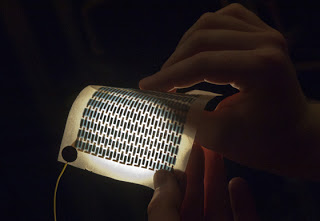Graduate student Miles Barr hold a flexible and foldable array of solar cells that have been printed on a sheet of paper. Photo: Patrick Gillooly
The technique represents a major departure from the systems used until now to create most solar cells, which require exposing the substrates to potentially damaging conditions, either in the form of liquids or high temperatures. The new printing process uses vapors, not liquids, and temperatures less than 120 degrees Celsius. These “gentle” conditions make it possible to use ordinary untreated paper, cloth or plastic as the substrate on which the solar cells can be printed.
Organic photovoltaic circuits are monolithically fabricated directly on a variety of common paper substrates using oxidative chemical vapor deposition to vapor print conformal conductive polymer electrodes. The paper photovoltaic arrays produce over 50 Volts, power common electronic displays in ambient indoor lighting, and can be tortuously flexed and folded without loss of function.
It is, to be sure, a bit more complex than just printing out a term paper. In order to create an array of photovoltaic cells on the paper, five layers of material need to be deposited onto the same sheet of paper in successive passes, using a mask (also made of paper) to form the patterns of cells on the surface. And the process has to take place in a vacuum chamber.
The basic process is essentially the same as the one used to make the silvery lining in your bag of potato chips: a vapor-deposition process that can be carried out inexpensively on a vast commercial scale.
The resilient solar cells still function even when folded up into a paper airplane. In their paper, the MIT researchers also describe printing a solar cell on a sheet of PET plastic (a thinner version of the material used for soda bottles) and then folding and unfolding it 1,000 times, with no significant loss of performance. By contrast, a commercially produced solar cell on the same material failed after a single folding.
18 pages of supporting information
Conductive, 150-nm thick, oCVD PEDOT polymer electrodes (100-1000 S∙cm-1) are
uniformly deposited on ultra-delicate substrates with no pre- or post-treatment and at identical conditions: ~10-μm thick SaranTM wrap (A, upper left), water-soluble rice paper (B, upper middle), and a single ply of bathroom tissue that is porous and absorbent (C, upper right). In 7 contrast, the conventional drop-cast conducting polymer solution (CleviosTM PH 750) does not wet the hydrophobic surface (A, lower left), easily dissolves the soluble substrate (B, lower middle), and soaks through and easily damages the delicate fiber matrix (C, lower right). Measurement in the lower half of the figure indicates the 2-point film resistances of 130Ω, 1200Ω, and 5.9 kΩ, respectively. (D) 200-nm thick, oCVD PEDOT polymer electrodes are vapor-patterned in situ directly on the substrate of choice. The figure shows examples of PEDOT printed in 15 pt. bold Verdana font on 10-mil thick PET, SaranTM wrap, Tracing Paper, and Tissue Paper. With the chemistry and conditions used here, the low vapor pressure of the FeCl3 oxidant at the substrate allows for pseudo-directional flow of this species through the mask to substrate. This, in combination with its fast reaction rate with the more-volatile EDOT monomer, creates well-defined oCVD PEDOT anodes in the masked pattern and prevents significant mask undercutting.
If you liked this article, please give it a quick review on ycombinator or StumbleUpon. Thanks

Brian Wang is a Futurist Thought Leader and a popular Science blogger with 1 million readers per month. His blog Nextbigfuture.com is ranked #1 Science News Blog. It covers many disruptive technology and trends including Space, Robotics, Artificial Intelligence, Medicine, Anti-aging Biotechnology, and Nanotechnology.
Known for identifying cutting edge technologies, he is currently a Co-Founder of a startup and fundraiser for high potential early-stage companies. He is the Head of Research for Allocations for deep technology investments and an Angel Investor at Space Angels.
A frequent speaker at corporations, he has been a TEDx speaker, a Singularity University speaker and guest at numerous interviews for radio and podcasts. He is open to public speaking and advising engagements.




